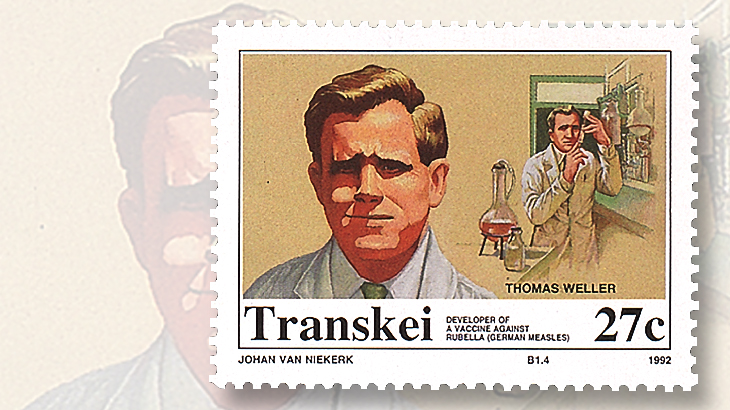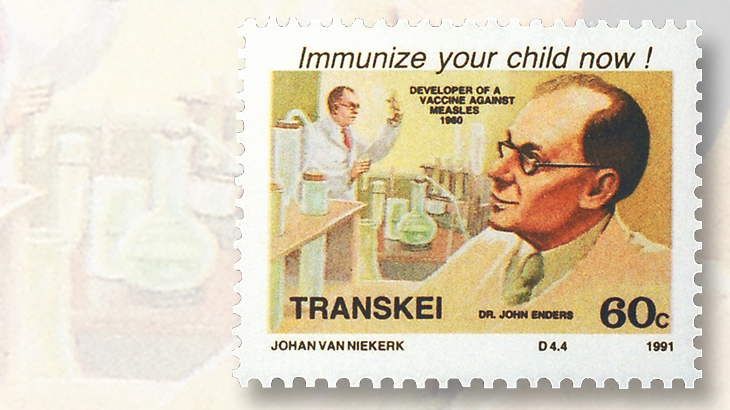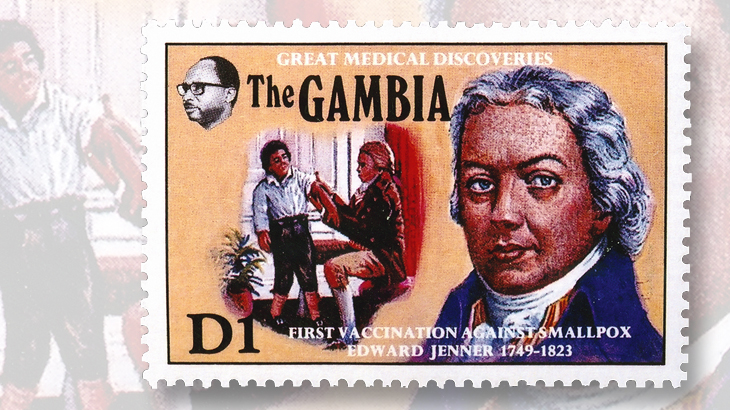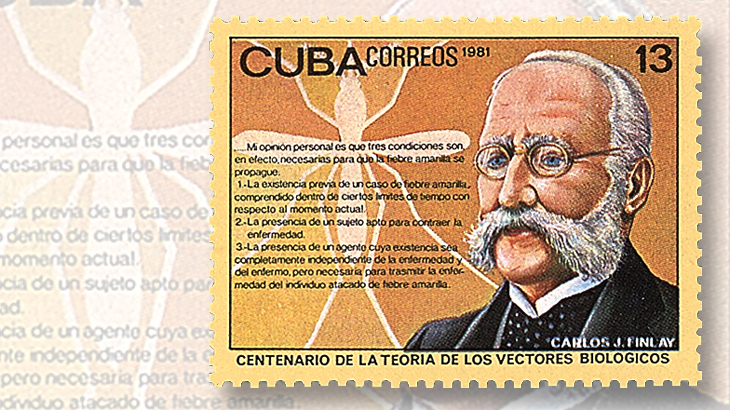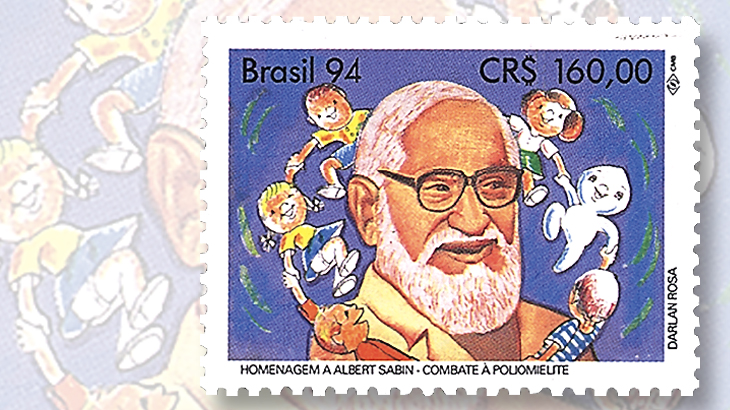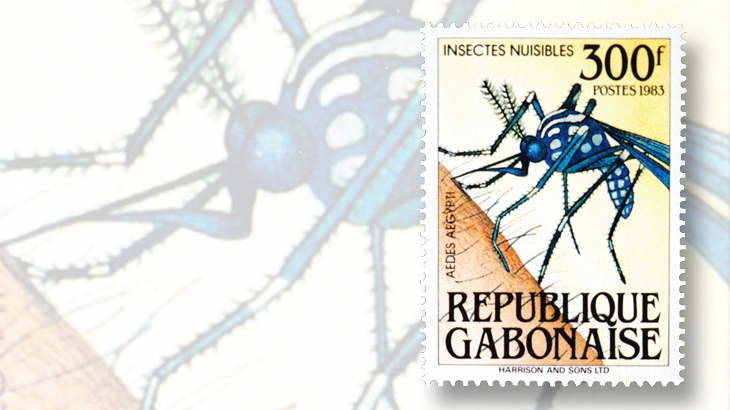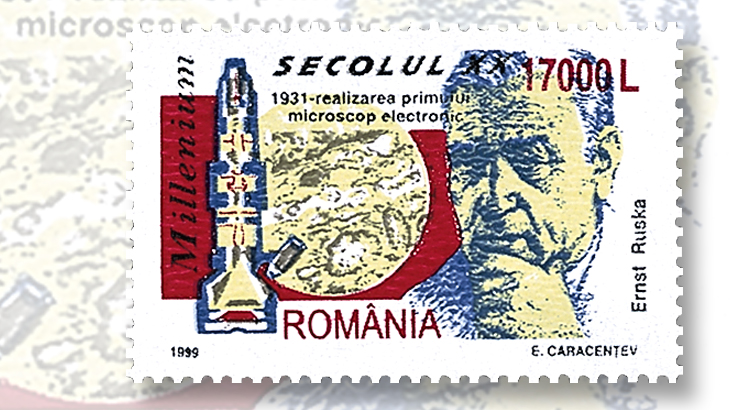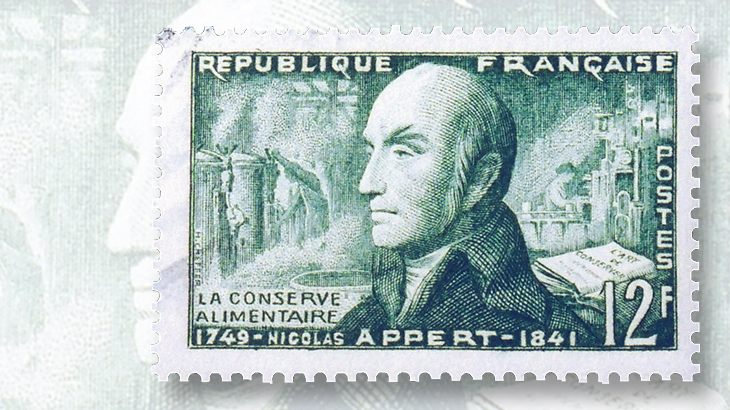World Stamps
Gone, but not forgotten? Heroes of science honored on stamps
By George Wistreich
In today’s busy world, a multitude of products are used to increase efficiencies, to combat diseases or to meet other perplexing challenges.
Canned goods, vaccines, and antibiotics are just a few examples of items in common use in various parts of the world, and used without much thought given to the individuals who developed or created them.
Who were these people? Here are a few examples of these individuals who, despite receiving recognition (sometimes philatelic) from their respective governments at one time, are not currently recognized globally to any great extent. Some of these scientists and their contributions might surprise you.
Canning
Canned foods have been around for many years and are in common use around the world. The process itself certainly is recognized as an efficient method for preserving various types of foods, but why and where did it start?
Connect with Linn’s Stamp News:
Sign up for our newsletter
Like us on Facebook
Follow us on Twitter
It has always been a fact that large armies require large amounts of quality food, and availability of a regular food supply is an important factor in the conducting of military campaigns.
France’s armies were engaged all over Europe in the late 1700s, and food spoiling over time and distance was a great problem. In 1795, the government offered a prize of 12,000 francs to anyone solving the problem of food preservation.
In 1809, after some 14 to 15 years of experimenting, Nicolas Appert (1749-1841), a French confectioner and brewer, succeeded in the airtight preservation of a variety of foodstuffs, including dairy products, meats, soups, jams and jellies.
His method, sometimes referred to as “appertization,” involved placing foods into large-mouthed glass bottles referred to as canning jars.
Sufficient air space was left at the top and then a cork was used to seal the contents, with the cork held firmly in place using a vise. This step was followed by wrapping the bottles in canvas to protect them while they were placed in boiling water for the length of time deemed necessary for thorough cooking of the contents.
Surprisingly, the food did not spoil. Even Appert did not understand why.
 |
9 Important Steps to Succesfully Soak Stamps: You can get a stamp collection going with just a few things most everyone can find around their home.Sign up for our free newsletter and we'll give you instant access to our exclusive Linn's Stamp News report. |
The reason remained a mystery until some 50 years later, when the French microbiologist Louis Pasteur, experimenting with the preservation of wines, determined the time and heating temperature needed to kill spoilage-causing bacteria without affecting the quality of the French wines.
While appertization may appear to be much the same as pasteurization, it is not. Appertization is a method of sterilizing canned foods, and pasteurization works by heating food products to a certain temperature range to destroy pathogenic organisms.
Appert won the 12,000fr prize, and his approach to canning was published in The Art of Preserving Animal and Vegetable Substances in 1810. It contained detailed descriptions of the canning process for more than 50 foods.
His work received critical acclaim, and Appert has been dubbed the “father of canning.”
His contribution is directly responsible for the many types of preserved foods that line the shelves of grocery stores around the world.
On March 5, 1955, France issued a 12-franc stamp (Scott 759) in his honor. The confectioner is pictured in profile and at left in the background are large vats. In the background at right, a woman surrounded by apparatus is probably carrying out the process. In the forefront at right is a copy of Appert’s book, with the title partly visible.
This French confectioner and chef also made other culinary contributions, including the invention of the bouillon cube.
Before leaving the topic of canning, mention should be made of British inventor and merchant Peter Durand, also of French origin, who patented his own food-preservation method using tin cans, thus heralding the modern-day process of food canning.
The first cans were robust containers and required a certain ingenuity to open them with available tools. The problem eased in 1855 when Robert Yates, an English cutlery and surgical instrument maker, devised the first claw-ended can opener.
Vaccines
In its original concept, the use of vaccines aimed to mimic the development of naturally acquired immunity (resistance) to an infectious disease, by the inoculation of a non-disease agent with the immunity-generating parts or products either of the disease agent (pathogen) in question or closely related pathogens.
The English physician Edward Jenner (1749-1821) first coined the term “vaccine” (from the Latin “vacca,” meaning cow) to describe the injecting of humans with the cowpox virus to provide protection against the human smallpox virus.
The Gambia, as well as a number of other countries, issued a stamp to honor the physician and the first vaccination against the virus disease. The 1-dalasy Gambia stamp (Scott 912), one of the Great Medical Pioneers set issued Dec. 12, 1989, pictures Jenner at right and a physician administering the vaccine at left.
From Jenner’s realization in 1796 that cowpox inoculation could protect humans from the smallpox virus, to the introduction of the Salk polio vaccine in 1955, and the measles vaccine in 1963, the means have been provided with which to either completely eliminate a disease such as smallpox — which killed millions of people through the centuries — or to greatly reduce the incidence of a number of infectious diseases, including measles, diphtheria, polio, and tetanus.
While routine immunization has become standard among many people in industrialized countries worldwide, how much thought is given to the dedicated and determined individuals responsible for and involved with the development of the vaccines? Let’s consider a few examples.
Substantial gains have been made toward the eradication of the viral disease poliomyelitis (polio), in large part through routine immunization with two polio vaccines.
The first of these, which contains killed virus, frequently is referred to the Salk vaccine, and was the result of the efforts of not only physician-virologist Jonas Salk (1914-1995) but a number of other individuals who belonged to his team of researchers.
The inactivated polio vaccine (IPV) was released in 1955 for general use to prevent the menacing effects of polio, and Salk became a public hero. He appears on a 1991 Transkei stamp (Scott 261).
While IPV was effective in preventing most of the complications of the disease, it did not prevent the initial intestinal infection with the virus.
The efforts of Albert Bruce Sabin (1906-2012), a Polish-American physician, and his Russian colleagues led to the perfection of the second of the polio vaccines to resolve the problem.
The Sabin vaccine contains live but weakened (attenuated) forms of polio virus strains. The living viruses stimulate the body’s immune system to defend the body against polio without causing the disease.
While Salk has been pictured on several stamps, Sabin has not been honored to the same extent, even though he played a key role in nearly eradicating polio.
A 160-cruzeiro real stamp issued by Brazil (Scott 2467) on April 7, 1994, a year after the scientist’s death, portrays a bespectacled, white-bearded Sabin with a circle of happy children dancing around his head.
The U.S. Postal Service honored Sabin with an 87¢ stamp issued March 8, 2006, in its Distinguished Americans series.
Sabin’s contributions did not end with the oral poliovirus vaccine. He developed vaccines against the mosquito-borne viral disease called dengue or breakbone fever.
Working with Harry Alfred Feldman, Sabin also developed a diagnostic test for toxoplasmosis. Toxoplasmosis is caused by a protozoan known for its ability to cause congenital infections and severe disease in persons with acquired immune deficiency syndrome (AIDS).
It is important to note that before either of the two polio vaccines could be developed, the virus first had to be grown outside of the body and in tissues that would allow its mass production. This challenge was met by John Franklin Enders, Thomas Huckle Weller, and Frederick Chapman Robbins. These three men were jointly awarded a Nobel Prize for their discovery.
In another area of virus research, Enders (1897-1954), together with Thomas C. Peebles (1921-2010), succeeded in isolating and growing measles virus. Their contribution led to the development of a measles vaccine.
In 1977, Dr. Maurice Hilleman (1919-2005) at the pharmaceutical firm Merck & Co. combined the measles vaccine with others into the MMR (measles, mumps and rubella) vaccine, protecting against all three common childhood illnesses.
On Sept. 26, 1991, Transkei issued a 60¢ stamp (Scott 262) honoring Enders. The stamp pictures the scientist, makes mention of the measles vaccine and emphasizes the need for childhood immunization. Ender’s contribution to the development of the polio virus vaccine is not noted.
Weller (1915-2008) is another member of the trio of scientists sharing the Nobel Prize in 1954 in recognition for the cultivation of the polio virus. Weller expanded his efforts in areas dealing with virus isolations and succeeded in isolating viruses that cause rubella (German measles), chicken pox (varicella), and shingles.
Subsequently, a newly developed varicella vaccine was added to the well-known trio of the MMR vaccine, giving rise to the MMRV vaccine in 2005.
On April 1, 1992, Transkei issued a 27¢ stamp (Scott 267) honoring Weller, with a portrait of the scientist in a laboratory environment.
Disease transmission
Over the past 50,000 to 100,000 years, as modern humans increased their numbers and spread throughout the world, newly identified infectious diseases also emerged, including those caused by viruses. One of these is the Zika virus.
First discovered in Uganda’s Zika (or Ziika) Forest in 1947, this mosquito-transmitted virus was long thought to be relatively harmless, especially when compared with other diseases such as malaria, a mosquito-borne disease caused by a parasite.
However, since its invasion in Brazil, Zika virus has spread through Latin America, the Pacific Islands and even the U.S. mainland, likely infecting millions and raising fears of a pandemic to a fever pitch.
Zika virus is primarily transmitted by Aedes species mosquitoes, of which Aedes aegypti is primarily involved. The signs and symptoms of the infection can include fever, painful joints, inflammation of the inner eyelid and a rash. These signs and symptoms usually last from several days to a week.
In the case of pregnancy, the infection also is known to cause an abnormal smallness of the brain (microcephaly) and other severe brain defects.
The transmission of viruses by mosquitoes, especially by Aedes aegypti, is not new. The first person to theorize that a mosquito, now referred to as a disease vector, was the transmitter of an infectious disease was Carlos Juan Finlay (1833-1915), a Spanish-Cuban physician. The disease was yellow fever and the disease vector identified by him in 1881 was Aedes aegypti.
Incidentally, the yellow fever virus was the first proven human disease-causing virus, in 1921.
On Aug. 14, 1981, Cuba issued a 13-centavo stamp (Scott 2431) honoring Finlay and celebrating the centenary of his theory of biological vectors.
The bespectacled physician is shown together with a listing of his three-step theory for the development of yellow fever. This stamp is missing the dates of Finlay’s life span; a subsequent Cuba stamp (Scott 3485) issued March 3, 1993, part of a set of eight stamps honoring scientists, lists his birth and death dates.
Yellow fever has an ancient history, dating back more than 3,000 years. The dangerous viral disease has occurred in major outbreaks worldwide, and was considered one of the most dangerous infectious diseases in the 18th and 19th centuries. It, along with malaria, was a major stumbling block in the building of the Panama Canal in the early 1900s.
Finlay published experimental evidence of his ideas in 1886, but to no effect until American physician Walter Reed took notice of Finlay’s mosquito-disease vector theory.
Reed refined the experimental process in 1900 and found that Aedes aegypti mosquitoes do indeed transmit yellow fever. His findings led to the subsequent implementation of mosquito control methods by U.S. Army physician William Gorgas (1854-1920) and the eradication of yellow fever in Panama.
Aedes aegypti mosquitoes originated in Africa but are now found in tropical and subtropical regions throughout the world.
The generic name comes from the ancient Greek meaning “unpleasant or odious.” In addition to transmitting the viral cause of Zika infection and yellow fever, Aedes aegypti and other species are known to transmit other viruses causing the previously mentioned dengue fever and West Nile fever.
Only the female bites mammalian hosts, to obtain blood necessary for reproductive purposes.
Unlike most other mosquitoes, Aedes species are active and bite during daytime hours. The mosquito is visually distinctive, having white and black stripes on its legs and body and a marking in the form of a harp (lyre) on a segment of its body.
On Nov. 9, 1983, Gabon issued a set of four stamps depicting harmful insects, including a 300-franc denomination illustrating the so-called yellow fever mosquito, Aedes aegypti (Scott 549).
The representation on the stamp is of a female mosquito and shows the proboscis — the long, thin mouth part used to penetrate the skin to obtain a blood meal — and the characteristic white markings on the insect’s legs. Because of the mosquito’s position, the typical harp-shaped marking on its body is not visible.
The electron microscope
Many of the extraordinary discoveries in the biological sciences have been inspired and made possible by a number of tools and techniques. One of these is the discovery of the microscopic and subsequently the submicroscopic worlds of living organisms.
Forms of life too small to see with the unaided human eye were first observed by Anton (or Antonie) van Leeuwenhoek (1632-1723).
Despite a lack of formal training in lens making, this cloth merchant in the town of Delft, the Netherlands, used simple one-lens microscopes of his own making to see and describe various forms of life we know today as algae, bacteria, protozoa, and yeasts.
Even though his small handheld instruments could magnify objects only about 200 times, van Leeuwenhoek expanded his observations to include blood cells, sperm, and eggs. Van Leeuwenhoek was honored on a 1982 Transkei stamp (Scott 98).
The magnifying and resolving capabilities of microscopes increased greatly with new inventions in the next 200 years.
In 1931, Max Knoll (1897-1969) and Ernst Ruska (1906-1988), two German physicists working at the Technical University of Berlin, invented a dramatically new investigative tool: the transmission electron microscope (TEM).
Instead of using visible light and glass lenses, the TEM uses electrons generated by an electron gun and then focused by electromagnetic coils to visualize objects, thus providing a greater ability to see detail.
Modern-day TEMs can achieve magnifications of at least one million times the detail of specimens measuring 0.1 nanometer (one-billionth of a meter). One meter is equal to 39.37 inches.
In 1937, the German physicist Manfred von Ardenne (1907-1937) invented a second type of electron microscope: the scanning electron microscope (SEM).
This instrument produces a three-dimensional view of a specimen by passing a beam of electrons over its surface (scanning), creating various signals containing information about the specimen’s surface. These signals are detected and collected to produce the image.
The uses of electron microscopes have contributed greatly to a number of scientific areas, especially the biological sciences.
Viruses, the structure and components of deoxyribonucleic acid (DNA), and numerous other biologically important molecules have been and continue to be revealed with specialized techniques and electron microscopes. These instruments have revolutionized concepts related to the structure of cells and how they interact.
Romania issued a stamp on Sept. 24, 1999, recognizing the development of the first transmission electron microscope, some 68 years after its invention.
The 17,000-leu stamp (Scott 4319) shows a thoughtful Ruska, only one of the co-developers. Knoll is not shown. Ruska was awarded a 1986 Nobel Prize in physics for his work in electron optics.
The 1999 Romania stamp for Ruska has a representation of the microscope, showing the internal diagrammatic arrangement of electromagnetic lenses within the instrument, together with a rather faint TEM image (electron micrograph).
The images obtained from today’s electron micrographs are far superior to the early ones.
While the persons mentioned in this article have received public recognition to some extent, they are now largely forgotten or perhaps never known by the general public, even though their contributions continue to benefit many.
MORE RELATED ARTICLES
Headlines
-
US Stamps
Oct 7, 2024, 3 PMMcMurtrie dismissed as APS education director following Sept. 21 arrest
-
US Stamps
Oct 7, 2024, 12 PMVasiliauskas named president of Mystic Stamp Co.
-
US Stamps
Oct 6, 2024, 5 PMApgar souvenir card available
-
US Stamps
Oct 6, 2024, 4 PMFirst Continental Congress and U.N. stamps receive Scott catalog numbers
